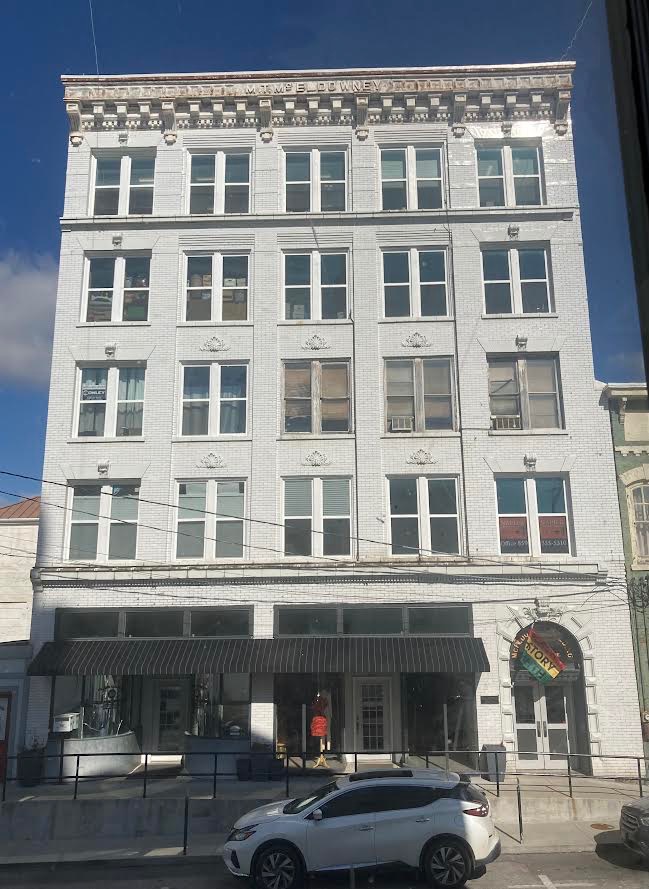Downtown Winchester is experiencing something of a renaissance with the opening of new restaurants, boutique shops, a microbrewery, and even a distillery.
Largely overlooked, however, is one of its biggest restoration projects, the McEldowney Building.
The tallest commercial building in the heart of downtown had seen better days when two young investors, Adam Kidd, and Demetrius Fassas, along with a silent partner, Demetrius’s first cousin, Matthew, bought it in September 2019 and began working to bring it back to life.
“We decided to take a chance on Winchester,” Demetrius said.
The deal was financially doable, and the location was ideal – right off Main Street on the courthouse square. And they liked the town, not only because of its proximity to Lexington, but because of the revitalization they saw happening around it.
“We have three new, big tenants moving in over the next three months, including where the ceramic studio used to be. Keep an eye out for those businesses.”
Adam Kidd
“You come downtown on a Saturday afternoon, and there are people walking the streets,” and it wasn’t like that a few years ago, Adam said. “There is momentum.”
“Both Adam and I were living there initially when we got started. I was there for the first year when we bought the building. And it was really heartening to see downtown business owners that were talking to each other and coming together and trying to figure out ways that we can drive more business into Winchester,” Demetrius said.
Four years later, the owners have spent close to $1.5 million on the building, including the purchase price. It is nearly full, including the state Administrative Office of the Courts, which leases space for judicial and county attorney offices, an artist’s studio, an architect’s office, union headquarters, and a large apartment.
Nearly all of the tenants are local, Adam said.
Until recently, Created by You, a ceramic art studio, leased an old bank building the partners own on Main Street and Broadway that is attached to the McEldowney Building. That space is also being refurbished.
“We have three new, big tenants moving in over the next three months, including where the ceramic studio used to be,” Adam said last Sunday. “Keep an eye out for those businesses.”
Demetrius said they would have liked to have bought the old McGuire Drug Store building at the corner of Main and Cleveland Avenue, but it was bought by a Louisville investor they know and like.

“It’s one of our biggest regrets” that they couldn’t include it, he said.
They’re about two-thirds of the way toward finishing the building, although it may never be completely finished, because as tenants come and go, there’s more work to be done.
Demetrius and Adam have known each other since high school. Demetrius is the executive director of a nonprofit “sober living home” in Montana, and Matthew is a musician in South Carolina. Adam is the project administrator for their company, DAM Holdings Inc., and is the hands-on developer of the property, as well as other properties they’ve purchased.
“Everybody has their full-time job. My job is painting walls,” Adam quipped.
Writing grant proposals and things like that is Demetrius’ area of expertise.
The Fassases and Kidd were all in their late 20s when they got involved in development as a way of making money for a comfortable retirement.
“We have learned so much in the last five years about developing. We’ve learned so much about running a business,” Demetrius said.
The original M.T. McEldowney Building, named for Winchester businessman Morgan Thomas McEldowney (1865−1934) was erected in 1906–1907 as a four-story building, and it was destroyed by fire the following year. At the time, its tenants included the U.S. Post Office, the Clark County Board of Education, and several businesses and lawyers’ offices, according to Clark County historian Harry Enoch. (WinCity Voices, Nov. 30, 2022)
After the fire, the building was replaced with a five-story building (six, including an underground parking garage) that was built almost entirely of concrete, steel, and brick to reduce the chances of a disastrous recurrence.
“It was built to be fireproof,” Demetrius remarked.
Demetrius said the interior walls were terracotta brick, and they removed tons of material when they renovated the fifth floor.
“We built it back with steel studs, which are much lighter,” he said.

At the same time, Adam said, he and his partners are also trying to be “historically minded” and use some of the original materials because they are stronger and will last longer than material that can be bought at a local lumber store.
They have used original doors and light fixtures, for example, but have put in new wiring, plumbing, and windows and have made the building “climate controlled” throughout.
“It is an awesome building. It was very lavish when it was built, so we’re trying to save that ritziness, that original feel to it,” he said.
They decided not to apply for historic preservation tax credits, Demetrius said, because trying to restore 180 windows to historic standards, for example, would have been cost-prohibitive. But they are doing what they can to return it to its original glory and make it a “completely professional and habitable” modern office space that will meet the needs of their tenants and pay off for the investors in the long run.
“We’re going to keep that building standing for another hundred years,” Adam said.



